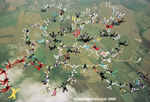

Brit 100 By: Simon Ward
(plus Pete Knight and Craig Poxon)

Smart mountaineers have a saying that when you get to the summit
you're only halfway. You still need to get down safely. In fact, the descent
can be the most challenging part. The same philosophy can be applied to big-ways
– there you are flying your slot in an amazing record formation, you think
it’s complete, your buddies are squeezing your wrists and there's magic in
the air – job done, you're on the summit. Woo hoo! Well you're only halfway,
now let’s get back down safely. Kate Cooper’s articles in the February and
April Mags expertly covered the skills needed to get to this point, now this
article covers getting down safely from the big-way so you can savour your
success in the bar.

Often big-ways separate in a number of waves – you must know
what altitude you should leave and what the break-off signal is (often leg
kicking or a deployment in the centre).
Also make sure you know what the break-off plan is if the
formation isn't complete or has funneled. I generally set my audible 500ft
higher than the first wave’s assigned break-off altitude. When it goes off
I know the signal is about to come and concentrate on looking for it. Also
if I was still approaching the formation and the beeps went I would stop my
approach immediately, knowing that the outer wave will be turning to leave
in about two seconds. If you go low, the standard brief is to move from beneath
the formation and keep working to get back up until the first wave breaks
off. When it’s your turn to go don't hesitate, make a lifting turn to face
away from the centre and go. Better still, don't put yourself low in the first
place! Flare out slightly early from your dive with a little altitude as insurance
and don't go flat to the formation too early. If you keep working the 45°
approach angle as Kate advised, you won’t ever go low.

The correct tracking direction is outwards on a line from the centre of
the formation to your slot. Just doing a 180° turn may not be correct and
could put you on a collision course. Cup air to lift as you turn and start
your track with just your legs, leaving your arms forward in a mantis position.
This avoids tipping too steeply at the start. Then slowly bring the arms
back. Keep looking around – left, right, forward, back between the legs,
up to the right, up to the left and pick a line maximising separation from
others. You need to track flat. If most people are higher, you are diving
too much, push down with the arms and suck up the stomach to gain more lift.
Track all the way to your assigned altitude regardless of where you are
over the ground. Even if you realise it’s a bad spot and you are tracking
away from the airfield, keep going. The priority at this stage is separation
on opening. Use your audible and/or check your alti to ensure you deploy
at your assigned height. You may wish to set your audible 500 ft higher
than your deployment altitude so you know when to stop tracking. If you
flare out to look at your wrist-mount alti too early you have already messed
up the separation plan.

You need to open within 300ft of your assigned altitude – so
know how long it takes you to wave off and deploy. Keep looking around as
you wave. If at this stage your tracking and observation has failed and you
wind up alongside somebody, you need to use your wits to ensure you don't
both deploy simultaneously – in this scenario separation is now more important
than your assigned deployment altitude. As you deploy keep your hips and shoulders
level, keep your eyes peeled and be prepared to use your rear risers to take
avoiding action if needed. Keep your canopy flying away from the centre for
at least 10 seconds to continue the separation.

The first part of flight safety begins on the ground with
your choice of canopy. If yours often has long snivels, opens off heading,
or is highly loaded then it’s not really suitable for big-ways. Find one which
is. Under canopy, leave your booties on and fly conservatively. Save your
spirals, CRW or swoops for smaller loads. Keep your head on a swivel the whole
way down. Decide promptly if you are going to make it back to your designated
landing area. If not then make an early decision on an alternate landing area
and spend the rest of the time scouring it for signs of hazards. (The most
serious injury on World Team 2006 was caused by hitting a power line during
an off landing.) Be aware that others may also be homing in on the same area
so try to join or set a pattern. You should aim to extend the stack of canopies.
If you're open higher than most of the pack, then sit on brakes and stay up
longer to free up some airspace. If open lower than most, then use 45° front
riser turns to motor on down and clear the air for those above. In a busier
sky than you may be used to, be aware of the burble behind other canopies
– especially close to the ground.

Know the landing direction in relation to the sun or some
other large distant object (eg, coastline or mountain range) before take-off.
Formation loads occasionally mistime exits and dump everyone off the airfield.
Know your assigned landing area and the pattern for landing and stick to it.
Don't make the most basic mistake of trying to land closest to the packing
area. The mission is separation so find a quieter part of your assigned landing
area. Often in light variable winds a landing direction will be set before
the jump. If this is the case, stick to this religiously even if it’s downwind.
It is better to land a bit faster than usual than meet a canopy going in the
opposite direction. Land straight-in if possible. If you must turn, do no
more than a predictable 90° having checked for traffic beforehand. Someone
may be approaching faster than you from behind.

After landing, immediately turn around and look up to check
others coming in to land. When clear, collect your canopy swiftly, and vacate
the landing area for the people above you. Keep your wits about you walking
back to the packing area. This is especially hard to do if you're all excited
as you've just built your largest formation – but being hit by someone surfing
in would really ruin your day! If the DZ hasn't implemented a post jump checking-in
procedure then buddy-up with someone on your aircraft and look out for each
other after every jump.

Now you made it back safely, mine’s a pint!
[Gordon wrote this article after watching Kirill Samotsvetov
(3 times world record holder) land hard after catching the burble behind another
canopy on the first jump of the world record sequential attempts. Kirill died
in surgery later that day. Just a fortnight earlier two world record holders
died in a canopy collision on a big-way in Georgia, USA.]



![]()